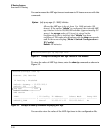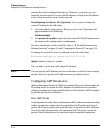
IP Routing Features
Configuring IP Parameters for Routing Switches
Configuring IP Parameters for Routing
Switches
The following sections describe how to configure IP parameters. Some param-
eters can be configured globally while others can be configured on individual
VLAN interfaces. Some parameters can be configured globally and overridden
for individual VLAN interfaces.
Note This section describes how to configure IP parameters for routing switches.
For IP configuration information when routing is not enabled, refer to the
chapter titled “Configuring IP Addressing” in the Management and Configu-
ration Guide for your routing switch.
Configuring IP Addresses
You can configure IP addresses on the routing switch’s VLAN interfaces.
Configuring IP addresses is described in detail in the chapter titled “Config-
uring IP Addressing” in the Management and Configuration Guide for your
switch.
Changing the Router ID
In most configurations, a routing switch has multiple IP addresses, usually
configured on different VLAN interfaces. As a result, a routing switch’s identity
to other devices varies depending on the interface to which the other device
is attached. Some routing protocols identify a routing switch by just one of
the IP addresses configured on the routing switch, regardless of the interfaces
that connect the routing switches. This IP address is the router ID.
Note Routing Information Protocol (RIP) does not use the router ID.
If no router ID is configured, then, by default, the router ID on a ProCurve
routing switch is the first IP address that becomes physically active at reboot.
This is usually the lowest numbered IP interface configured on the device.
However, if no router ID is configured and one or more user-configured
loopback interfaces are detected at reboot, then the lowest-numbered (user-
configured) loopback interface becomes the router ID. If the lowest-
numbered loopback interface has multiple IP addresses, then the lowest of
these addressees will be selected as the router ID. Once a router ID is selected,
it will not automatically change unless a higher-priority interface is configured
on the routing switch. (User-Configured loopback interfaces are always higher
3-13


















